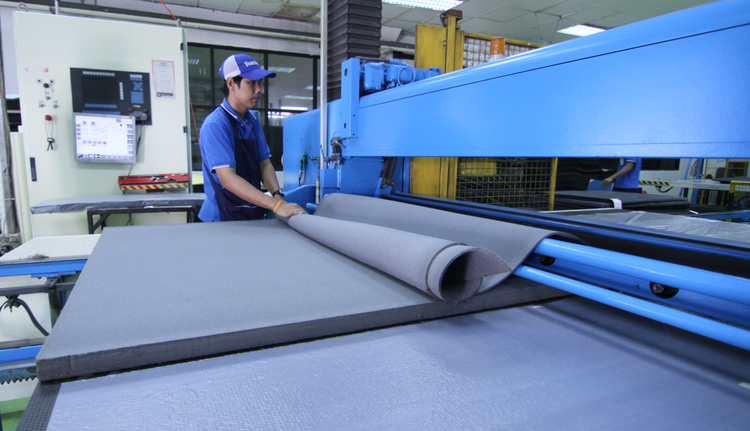[et_pb_section fb_built=”1″ admin_label=”section” _builder_version=”4.16″ da_disable_devices=”off|off|off” global_colors_info=”{}” da_is_popup=”off” da_exit_intent=”off” da_has_close=”on” da_alt_close=”off” da_dark_close=”off” da_not_modal=”on” da_is_singular=”off” da_with_loader=”off” da_has_shadow=”on”][et_pb_row admin_label=”row” _builder_version=”4.16″ background_size=”initial” background_position=”top_left” background_repeat=”repeat” global_colors_info=”{}”][et_pb_column type=”4_4″ _builder_version=”4.16″ custom_padding=”|||” global_colors_info=”{}” custom_padding__hover=”|||”][et_pb_text admin_label=”Text” _builder_version=”4.16″ background_size=”initial” background_position=”top_left” background_repeat=”repeat” global_colors_info=”{}”]The manufacturing of medical-grade polyurethane foam begins with the selection and preparation of raw materials. These materials typically include polyols, isocyanates, blowing agents, catalysts, and additives. Polyols and isocyanates serve as the main components of the foam, while blowing agents create the desired cellular structure. Catalysts help initiate the foam formation process, and additives provide additional properties such as flame retardancy or antimicrobial properties. Each raw material is carefully measured and mixed according to specific formulations to achieve the desired characteristics of the foam.
The preparation of the raw materials involves ensuring their purity and compatibility. Contaminants or impurities can negatively impact the foam’s quality and performance, so manufacturers carefully source high-quality materials and conduct thorough testing. Additionally, the compatibility of different raw materials is crucial to ensure a stable and consistent foam production process. Compatibility testing helps identify potential issues or incompatibilities affecting the final product.
Once the raw materials are prepared, they are ready for the polyurethane foam production process.
Polyurethane Foam Production Techniques
Polyurethane foam production techniques involve a series of steps that transform the prepared raw materials into foam components. The process typically includes the following stages:
– Mixing: The prepared polyols, isocyanates, blowing agents, catalysts, and additives are mixed together in specific ratios. This mixture is often referred to as foam formulation.
– Dispensing: The foam formulation is dispensed onto a moving conveyor production line. The chemical mixing and dispensing process is tightly measured and automated.
– Expansion: Once dispensed, the foam formulation undergoes a chemical reaction as a controlled expansion process. This expansion is facilitated by the blowing agents, which create bubbles or cells within the foam structure. The expansion process allows the foam to achieve its desired density, porosity, and physical properties.
– Curing: After expansion, the foam components are left to cure. This curing process typically involves allowing the foam to stabilize, which further enhances its structural integrity and properties. The curing time may vary depending on the specific foam formulation and physical characteristics.
Polyurethane foam production techniques require precision, control, and adherence to specific parameters to ensure consistent and high-quality foam components. The production techniques set the stage for the raw foam to be manufactured with the pore size, density, color, and hydrophilic/hydrophobic characteristics within established tolerances needed for the final part.
Converting Polyurethane Foam
Polyurethane foam for medical devices is processed into a wide range of component parts including cushioning, protecting, or enhancing the device. For instance,
- Felting
- Convolution
- Laser Die Cutting
- Vertical & Horizontal Cutting
- Lamination
- Hot Forming
The processes can extend the device life through temperature or vibration control, improve end-user comfort through biocompatibility, cushioning and support, or enhance device performance by protecting sensitive parts.
Quality Control and Safety Measures
Ensuring the quality and safety of polyurethane foam components controls and reduces risk for products designed for the medical device industry. Manufacturers follow stringent traceability and quality control measures throughout the manufacturing process to maintain consistency and meet regulatory standards. Some key quality control measures include:
– Raw Material Testing: Before use, each raw material undergoes thorough testing to ensure its purity, compatibility, and compliance with regulatory requirements. Testing may include physical, chemical, and biological evaluations. This testing is certified by the manufacturer of that chemical.
– Process Monitoring: GMP foam manufacturers closely monitor the polyurethane foam production process to ensure that all parameters, such as temperature, pressure, and mixing ratios, are within specified ranges. Regular checks and adjustments are made to maintain product consistency and quality. Records are maintained for all of this data.
– Product Testing: Finished foam components undergo extensive testing to evaluate their physical, mechanical, and biocompatibility properties. Testing may include compression testing, tensile strength testing, flammability testing, and cytotoxicity testing, among others.
– Quality Management Systems: Manufacturers implement quality management systems, such as ISO 13485 and compliance to 21 CFR 820, to ensure consistent quality control practices and compliance with regulatory requirements.
By maintaining strict quality control and safety measures, manufacturers can produce high-quality polyurethane foam components that meet the rigorous standards of the medical device industry.
Foamtec International’s Medical Division is a vertically integrated manufacturer and converter of polyurethane foam components for medical devices. Learn more about our capabilities for your next project.[/et_pb_text][et_pb_button button_url=”#short-form” button_text=”Contact Us” button_alignment=”center” _builder_version=”4.23.4″ _module_preset=”default” global_colors_info=”{}”][/et_pb_button][/et_pb_column][/et_pb_row][/et_pb_section][et_pb_section fb_built=”1″ admin_label=”Popup – #short-form” module_id=”short-form” module_class=”popup” _builder_version=”4.19.1″ _module_preset=”default” width=”950px” da_is_popup=”on” da_popup_slug=”short-form” da_disable_devices=”off|off|off” border_radii=”on|12px|12px|12px|12px” box_shadow_style=”preset1″ global_colors_info=”{}” da_exit_intent=”off” da_has_close=”on” da_alt_close=”off” da_dark_close=”off” da_not_modal=”on” da_is_singular=”off” da_with_loader=”off” da_has_shadow=”on”][et_pb_row _builder_version=”4.19.1″ _module_preset=”default” width=”85%” global_colors_info=”{}”][et_pb_column type=”4_4″ _builder_version=”4.19.1″ _module_preset=”default” global_colors_info=”{}”][et_pb_text _builder_version=”4.19.1″ _module_preset=”default” header_3_font=”|700|||||||” header_3_text_align=”center” header_3_text_color=”#283891″ global_colors_info=”{}”]
Tell Us About Your Project
[/et_pb_text][et_pb_code _builder_version=”4.19.1″ _module_preset=”default” width=”80%” module_alignment=”center” custom_padding=”25px|25px|25px|25px|true|true” border_radii=”on|12px|12px|12px|12px” border_width_all=”1px” border_color_all=”#CCE3E2″ global_colors_info=”{}”]




